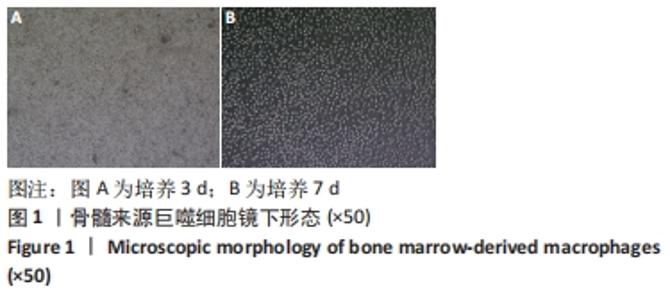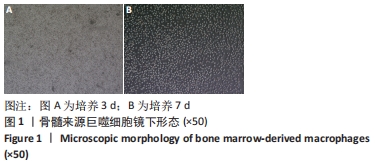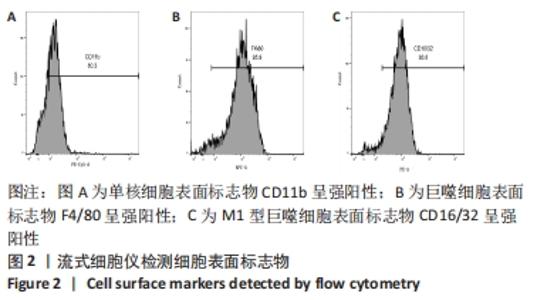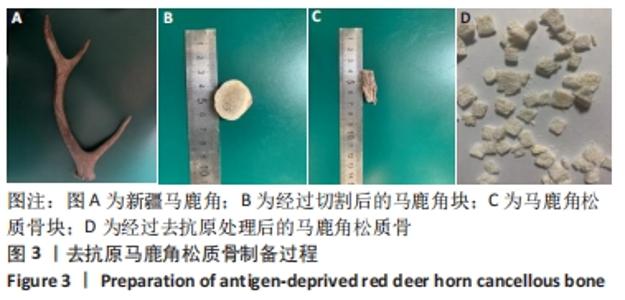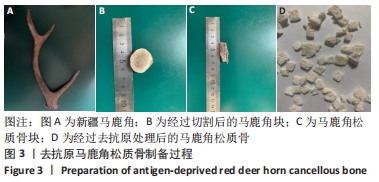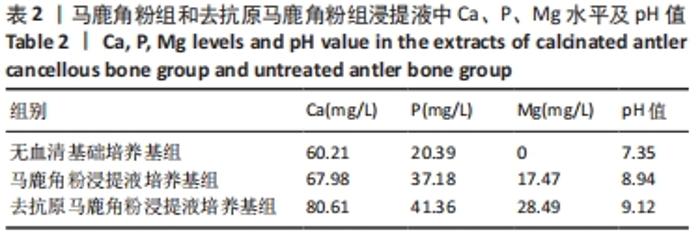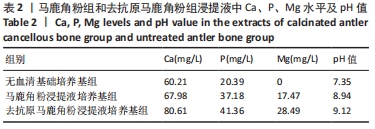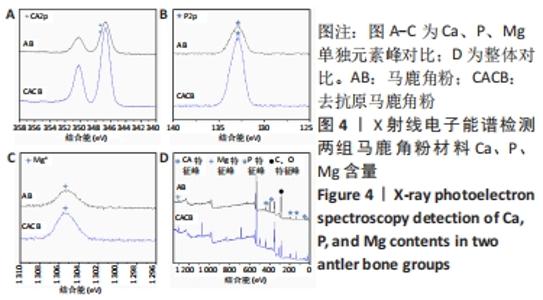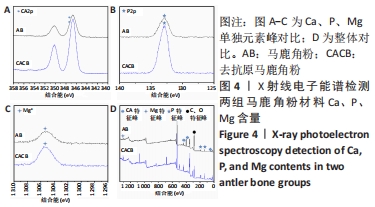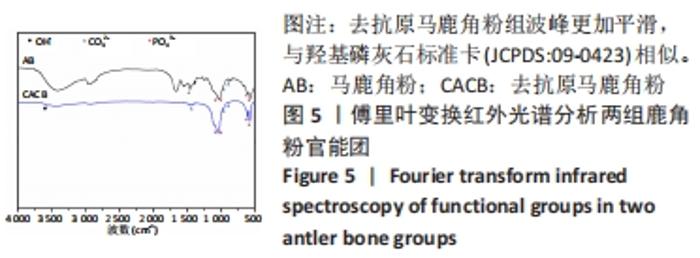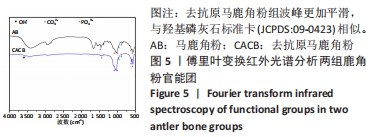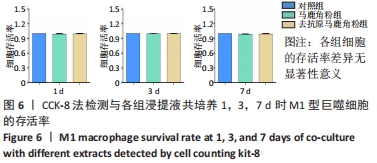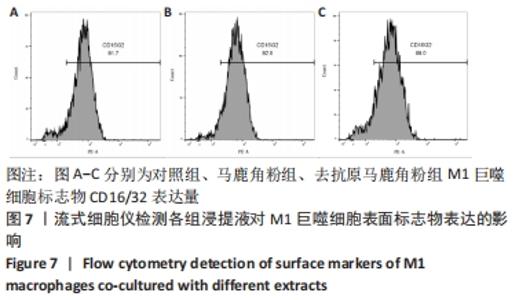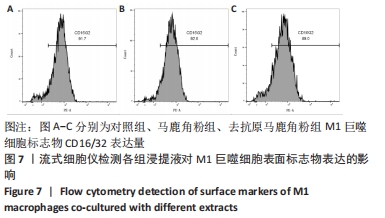Chinese Journal of Tissue Engineering Research ›› 2022, Vol. 26 ›› Issue (24): 3840-3845.doi: 10.12307/2022.563
Previous Articles Next Articles
Effects of red deer horn powder extract on the biological behavior of bone marrow derived macrophages
Shan Shuai1, Dong Yi1, Liu Jialin1, Han Xiangzhen1, He Huiyu1, 2
- 1Department of Prosthodontics and Implant, The First Affiliated Hospital of Xinjiang Medical University, Urumqi 830054, Xinjiang Uygur Autonomous Region, China; 2Xinjiang Institute of Stomatology, Urumqi 830054, Xinjiang Uygur Autonomous Region, China
-
Received:2021-09-23Accepted:2021-11-03Online:2022-08-28Published:2022-01-24 -
Contact:He Huiyu, Chief physician, Professor, Doctoral supervisor, Master’s supervisor, Department of Prosthodontics and Implant, The First Affiliated Hospital of Xinjiang Medical University, Urumqi 830054, Xinjiang Uygur Autonomous Region, China; Xinjiang Institute of Stomatology, Urumqi 830054, Xinjiang Uygur Autonomous Region, China -
About author:Shan Shuai, Master candidate, Department of Prosthodontics and Implant, The First Affiliated Hospital of Xinjiang Medical University, Urumqi 830054, Xinjiang Uygur Autonomous Region, China -
Supported by:the Science and Technology Support Project of Xinjiang Uygur Autonomous Region, No. 2018E02060 (to HHY); Postgraduate Research and Innovation Project of Xinjiang Uygur Autonomous Region, No. XJ2021G196 (to LJL)
CLC Number:
Cite this article
Shan Shuai, Dong Yi, Liu Jialin, Han Xiangzhen, He Huiyu. Effects of red deer horn powder extract on the biological behavior of bone marrow derived macrophages[J]. Chinese Journal of Tissue Engineering Research, 2022, 26(24): 3840-3845.
share this article
Add to citation manager EndNote|Reference Manager|ProCite|BibTeX|RefWorks
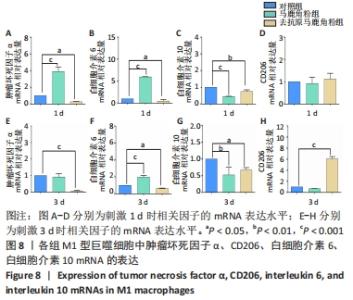
2.8 各组M1巨噬细胞肿瘤坏死因子α、CD206、白细胞介素6、白细胞介素10 mRNA表达 qRT-PCR结果显示,M1型巨噬细胞与各组浸提液共培养1,3 d后,与对照组相比,去抗原马鹿角粉组巨噬细胞的促炎因子肿瘤坏死因子α、白细胞介素6以及抑炎因子白细胞介素10均在不同程度被下调(P < 0.05,P < 0.01);而对于马鹿角粉组来说,共培养3 d的肿瘤坏死因子α表达量与对照组相比没有统计学意义,共培养1 d的肿瘤坏死因子α、白细胞介素6及共培养3 d的白细胞介素6促炎因子表达均明显高于对照组(P < 0.001),共培养1,3 d的白细胞介素10表达明显低于对照组(P < 0.001,P < 0.01);共培养1,3 d,马鹿角粉组M2巨噬细胞标志因子CD206表达与对照组之间均无统计学意义;共培养1 d,去抗原马鹿角粉组CD206表达稍高于对照组但无统计学意义;共培养3 d,去抗原马鹿角粉组CD206表达明显高于对照组(P < 0.001),可见在共培养3 d后,去抗原马鹿角粉组刺激的M1型巨噬细胞有明显M2型极化的迹象,见图8。"
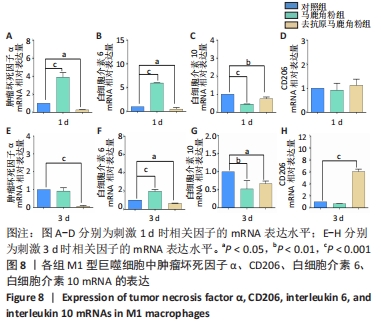
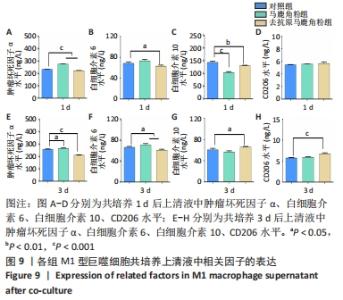
2.9 各组M1型巨噬细胞上清液中肿瘤坏死因子α、CD206、白细胞介素6、白细胞介素10水平 ELISA结果显示,共培养1,3 d,去抗原马鹿角粉组上清液中促炎因子肿瘤坏死因子α以及白细胞介素6水平均被不同程度抑制(P < 0.001,P < 0.05),这一结果与先前PCR的结果保持一致;但去抗原马鹿角粉组在刺激3 d后抗炎因子白细胞介素10水平高于对照组(P < 0.05),这与之前PCR结果稍有不同;去抗原马鹿角粉组CD206水平与PCR结果也保持一致,在共培养3 d明显高于对照组。对于马鹿角粉组,共培养1 d时白细胞介素6水平与对照组无统计学意义,其余指标与PCR的结果大致一致;马鹿角粉组CD206水平与对照组无统计学意义,与PCR的结果也保持一致,见图9。"
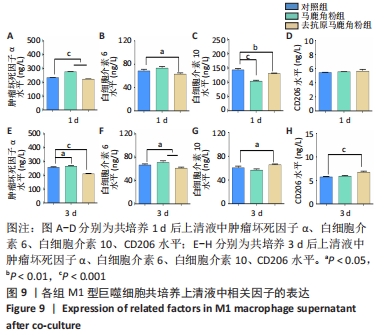
| [1] 贺唯,樊瑜波,李晓明,等.骨修复材料活性机制和应用的最新研究进展[J].中国修复重建外科杂志,2018,32(9):1107-1115. [2] MONTERO J, BECERRO A, PARDAL-PELÁEZ B, et al. Main 3D Manufacturing Techniques for Customized Bone Substitutes. A Systematic Review. Materials (Basel). 2021;14(10):2524. [3] SWETHA S, LAVANYA K, SRUTHI R, et al. An insight into cell-laden 3D-printed constructs for bone tissue engineering. J Mater Chem B. 2020;8(43):9836-9862. [4] PARK SA, LEE HJ, KIM KS, et al. In Vivo Evaluation of 3D-Printed Polycaprolactone Scaffold Implantation Combined with β-TCP Powder for Alveolar Bone Augmentation in a Beagle Defect Model. Materials (Basel). 2018;11(2):238. [5] BELLO YD, DI DOMENICO MB, MAGRO LD, et al. Bond strength between composite repair and polymer-infiltrated ceramic-network material: Effect of different surface treatments. J Esthet Restor Dent. 2019;31(3):275-279. [6] KHAN MUA, ABD RAZAK SI, MEHBOOB H, et al. Synthesis and Characterization of Silver-Coated Polymeric Scaffolds for Bone Tissue Engineering: Antibacterial and In Vitro Evaluation of Cytotoxicity and Biocompatibility. ACS Omega. 2021; 6(6):4335-4346. [7] KLOPFLEISCH R, JUNG F. The pathology of the foreign body reaction against biomaterials. J Biomed Mater Res A. 2017;105(3):927-940. [8] JAYASINGAM SD, CITARTAN M, THANG TH, et al. Evaluating the Polarization of Tumor-Associated Macrophages Into M1 and M2 Phenotypes in Human Cancer Tissue: Technicalities and Challenges in Routine Clinical Practice. Front Oncol. 2020;9:1512. [9] CHU C, LIU L, WANG Y, et al. Macrophage phenotype in the epigallocatechin-3-gallate (EGCG)-modified collagen determines foreign body reaction. J Tissue Eng Regen Med. 2018;12(6):1499-1507. [10] GUILLIAMS M, MILDNER A, YONA S. Developmental and Functional Heterogeneity of Monocytes. Immunity. 2018;49(4):595-613. [11] HU Z, MA C, RONG X, et al. Immunomodulatory ECM-like Microspheres for Accelerated Bone Regeneration in Diabetes Mellitus. ACS Appl Mater Interfaces. 2018;10(3):2377-2390. [12] 赵小琦. 3D打印马鹿角粉组织工程骨支架的体外及体内实验研究[D].乌鲁木齐:新疆医科大学,2019. [13] 赵小琦,丁刘闯,韩祥祯,等.3D打印鹿角粉/聚乙烯醇支架与纳米级羟基磷灰石/聚乙烯醇支架的性能比较[J].口腔医学研究,2018,34(9):1011-1015. [14] MENG S, ZHANG X, XU M, et al. Effects of deer age on the physicochemical properties of deproteinized antler cancellous bone: an approach to optimize osteoconductivity of bone graft. Biomed Mater. 2015;10(3):035006. [15] 陈毓,李锋涛,钱大玮,等.马鹿角及梅花鹿角脱盘中无机元素分析与评价[J].中成药,2014,36(12):2577-2582. [16] PICAVET PP, BALLIGAND M. Organic and mechanical properties of Cervidae antlers: a review. Vet Res Commun. 2016;40(3-4):141-147. [17] 张亚楠,严霞,孟增东.Zn、Mg增强羟基磷灰石骨修复材料临床应用与机制:生物活性及成骨诱导的研究进展[J].中国组织工程研究,2020,24(4):606-611. [18] HU T, XU H, WANG C, et al. Magnesium enhances the chondrogenic differentiation of mesenchymal stem cells by inhibiting activated macrophage-induced inflammation. Sci Rep. 2018;8(1):3406. [19] 胡涂.镁通过调控巨噬细胞极化影响间充质干细胞软骨分化的研究[D].上海:上海交通大学,2018. [20] ALMEIDA JC, WACHA A, GOMES PS, et al. A biocompatible hybrid material with simultaneous calcium and strontium release capability for bone tissue repair. Mater Sci Eng C Mater Biol Appl. 2016;62:429-438. [21] LIU E, LI Z, ZHANG Y, et al. Hepcidin Induces M1 Macrophage Polarization in Monocytes or THP-1 Derived Macrophages. Iran J Immunol. 2019;16(3):190-199. [22] ROCHELSON B, DOWLING O, SCHWARTZ N, et al. Magnesium sulfate suppresses inflammatory responses by human umbilical vein endothelial cells (HuVECs) through the NFkappaB pathway. J Reprod Immunol. 2007;73(2):101-107. [23] LI B, CAO H, ZHAO Y, et al. In vitro and in vivo responses of macrophages to magnesium-doped titanium. Sci Rep. 2017;7:42707. [24] 孟松,张学慧,邓旭亮.煅烧鹿角松质骨浸提液对BMSCs成骨分化的影响[J].现代口腔医学杂志,2015,29(3):129-132. [25] HE C, LARSON-CASEY JL, GU L, et al. Cu,Zn-Superoxide Dismutase-Mediated Redox Regulation of Jumonji Domain Containing 3 Modulates Macrophage Polarization and Pulmonary Fibrosis. Am J Respir Cell Mol Biol. 2016;55(1):58-71. [26] WU H, ZHAO G, JIANG K, et al. Plantamajoside ameliorates lipopolysaccharide-induced acute lung injury via suppressing NF-κB and MAPK activation. Int Immunopharmacol. 2016;35:315-322. [27] ZHOU X, YANG W, LI J. Ca2+- and protein kinase C-dependent signaling pathway for nuclear factor-kappaB activation, inducible nitric-oxide synthase expression, and tumor necrosis factor-alpha production in lipopolysaccharide-stimulated rat peritoneal macrophages. J Biol Chem. 2006;281(42):31337-31347. [28] GAO F, DING B, ZHOU L, et al. Magnesium sulfate provides neuroprotection in lipopolysaccharide-activated primary microglia by inhibiting NF-κB pathway. J Surg Res. 2013;184(2):944-950. |
| [1] | Liu Jin, Li Zhen, Hao Huiqin, Wang Ze, Zhao Caihong, Lu Wenjing. Ermiao san aqueous extract regulates proliferation, migration, and inflammatory factor expression of fibroblast-like synovial cells in collagen-induced arthritis rats [J]. Chinese Journal of Tissue Engineering Research, 2022, 26(5): 688-693. |
| [2] | Li Shidan, Xing Wei, Xie Xiaoyu, Li Youbin, Wang Shaochuan, Fei Jun. A new method for extracting human bone marrow mesenchymal stem cells and the comparison with traditional methods [J]. Chinese Journal of Tissue Engineering Research, 2022, 26(24): 3814-3820. |
| [3] | Li Jing, Qiao Wei, Ren Xiaoqi, Shi Hao, Yang Ting, Ma Shaoying, Su Chengzhong, Li Baoxing, Zhao Yaping. Calcined bovine bone combined with acellular dermal matrix for maintaining the alveolar ridge in dog [J]. Chinese Journal of Tissue Engineering Research, 2022, 26(22): 3445-3449. |
| [4] | Hu Yanan, Wang Ping, Du Haitao, Jing Tianyuan, Wang Chengcheng. Mechanism by which antler glue treats avascular necrosis of the femoral head induced by retinoic acid in rats: a serum proteomics study [J]. Chinese Journal of Tissue Engineering Research, 2022, 26(14): 2243-2251. |
| [5] | Hu Taotao, Chang Shusen, Wei Zairong. Macrophage polarization effectively promotes nerve regeneration after peripheral nerve injury through the M2 phenotypic regulation [J]. Chinese Journal of Tissue Engineering Research, 2022, 26(14): 2285-2290. |
| [6] | Li Lichun, Li Xiaofeng, Li Jianping. Potential new target effects between exosomes derived from mesenchymal stem cells and various hematological tumors [J]. Chinese Journal of Tissue Engineering Research, 2022, 26(13): 2099-2105. |
| [7] | Zhao Yuexin, Chen Bin. Progress of macrophage polarization in immunology of bone tissue engineering [J]. Chinese Journal of Tissue Engineering Research, 2022, 26(13): 2120-2126. |
| [8] | Zhao Yiming, Wang Jie, Zhang Gaowei, Sun Jianjun, Yang Peng. Recognition of human lower limb movement intention based on surface electromyography of lower limb corresponding to five gaits [J]. Chinese Journal of Tissue Engineering Research, 2022, 26(12): 1805-1811. |
| [9] | Dong Hongfei, Huang Qilin, Yang Xiong, Li Shuai, Gu Rui, Sun Hongyu, Tang Lijun. Dermal extracellular matrix hydrogel in promoting acute skin wound healing in rats [J]. Chinese Journal of Tissue Engineering Research, 2022, 26(10): 1555-1560. |
| [10] | Liu Xiaoyuan, Li Lei, Zhang Kai, Li Jun, Han Xiangzhen He Huiyu. Osteogenesis using bone marrow mesenchymal stem cell sheets combined with three-dimensional printed Cervus elaphus antler powder/silk fibroin/polyvinyl alcohol scaffold in vivo [J]. Chinese Journal of Tissue Engineering Research, 2021, 25(34): 5420-5426. |
| [11] | Zhu Bikang, Luo Shanchao, Luo Shixing. Progress and main application of fish skin collagen in tissue engineering [J]. Chinese Journal of Tissue Engineering Research, 2021, 25(28): 4561-4566. |
| [12] | Zuo Zhenkui, Han Jiarui, Ji Shuling, He Lulu. Pretreatment with ginkgo biloba extract 50 alleviates radiation-induced acute intestinal injury in mice [J]. Chinese Journal of Tissue Engineering Research, 2021, 25(23): 3666-3671. |
| [13] | Tian Guangzhao, Yang Zhen, Zha Kangkang, Sun Zhiqiang, Li Xu, Sui Xiang, Huang Jingxiang, Guo Quanyi, Liu Shuyun. Regulatory effect of decellularized cartilage matrix on macrophage polarization [J]. Chinese Journal of Tissue Engineering Research, 2021, 25(22): 3545-3550. |
| [14] | Huang Zhusong, Lin Yu, Chen Xiang, Lan Jinfu, Guan Yong, Gao Xi. Alcohol extract of Morinda officinalis improves lipid metabolism and bone metabolism in ovariectomized obese rats [J]. Chinese Journal of Tissue Engineering Research, 2021, 25(2): 205-210. |
| [15] | Fu Yuanfei, He Shenghua, Lai Juyi, Sun Zhitao, Feng Hualong, Lan Zhiming . Pheretima extract ameliorates nucleus pulposus cell degeneration in the intervertebral disc by inhibiting nuclear factor-kappa B pathway [J]. Chinese Journal of Tissue Engineering Research, 2021, 25(2): 264-268. |
| Viewed | ||||||
|
Full text |
|
|||||
|
Abstract |
|
|||||
